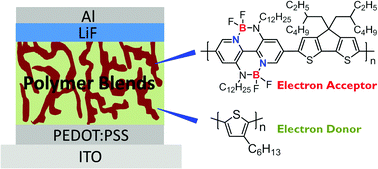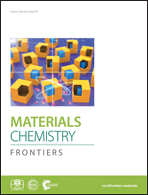A double B←N bridged bipyridine (BNBP)-based polymer electron acceptor: all-polymer solar cells with a high donor : acceptor blend ratio†
Abstract
A new polymer electron acceptor (P-BNBP-CDT) composed of an alternating double B←N bridged bipyridine (BNBP) unit and a cyclopenta-[2,1-b:3,4-b′]-dithiophene (CDT) unit has been developed. P-BNBP-CDT exhibits strong light absorption in the visible range of 500–650 nm and suitable LUMO/HOMO energy levels (ELUMO/HOMO) of −3.45 eV/−5.64 eV, which are very complementary to that (ELUMO/HOMO = −3.2 eV/−5.2 eV) of the widely-used polymer donor, poly(3-hexylthiophene) (P3HT). All-polymer solar cells (all-PSCs) with P3HT as an electron donor and P-BNBP-CDT as an electron acceptor exhibit power conversion efficiencies (PCEs) exceeding 1.0% with high donor : acceptor blend ratios (w : w, from 0.5 : 1 to 9 : 1). The highest PCE of these devices is 1.76% with a high donor : acceptor blend ratio of 5 : 1. These results not only indicate that BNBP-based polymers are promising for P3HT : polymer acceptor devices, but also suggest the potential for low cost and facile device processing of all-PSCs.


 Please wait while we load your content...
Please wait while we load your content...